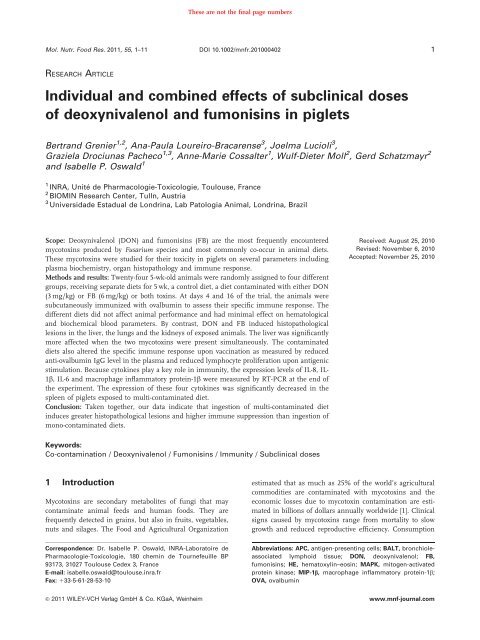Effet chez le porcelet d'une exposition à un régime co-contaminé en ...
Effet chez le porcelet d'une exposition à un régime co-contaminé en ...
Effet chez le porcelet d'une exposition à un régime co-contaminé en ...
You also want an ePaper? Increase the reach of your titles
YUMPU automatically turns print PDFs into web optimized ePapers that Google loves.
These are not the final page numbersMol. Nutr. Food Res. 2011, 55, 1–11 DOI 10.1002/mnfr.2010004021RESEARCH ARTICLEIndividual and <strong>co</strong>mbined effects of subclinical dosesof deoxyniva<strong>le</strong>nol and fumonisins in pig<strong>le</strong>tsBertrand Gr<strong>en</strong>ier 1,2 , Ana-Paula Loureiro-Bracar<strong>en</strong>se 3 , Joelma Lucioli 3 ,Graziela Droci<strong>un</strong>as Pache<strong>co</strong> 1,3 , Anne-Marie Cossalter 1 , Wulf-Dieter Moll 2 , Gerd Schatzmayr 2and Isabel<strong>le</strong> P. Oswald 11 INRA, Unité de Pharma<strong>co</strong>logie-Toxi<strong>co</strong>logie, Toulouse, France2 BIOMIN Research C<strong>en</strong>ter, Tulln, Austria3 Universidade Estadual de Londrina, Lab Patologia Animal, Londrina, BrazilS<strong>co</strong>pe: Deoxyniva<strong>le</strong>nol (DON) and fumonisins (FB) are the most frequ<strong>en</strong>tly <strong>en</strong><strong>co</strong><strong>un</strong>teredmy<strong>co</strong>toxins produced by Fusarium species and most <strong>co</strong>mmonly <strong>co</strong>-occur in animal diets.These my<strong>co</strong>toxins were studied for their toxicity in pig<strong>le</strong>ts on several parameters includingplasma biochemistry, organ histopathology and imm<strong>un</strong>e response.Methods and results: Tw<strong>en</strong>ty-four 5-wk-old animals were randomly assigned to four differ<strong>en</strong>tgroups, receiving separate diets for 5 wk, a <strong>co</strong>ntrol diet, a diet <strong>co</strong>ntaminated with either DON(3 mg/kg) or FB (6 mg/kg) or both toxins. At days 4 and 16 of the trial, the animals weresubcutaneously imm<strong>un</strong>ized with ovalbumin to assess their specific imm<strong>un</strong>e response. Thediffer<strong>en</strong>t diets did not affect animal performance and had minimal effect on hematologicaland biochemical blood parameters. By <strong>co</strong>ntrast, DON and FB induced histopathological<strong>le</strong>sions in the liver, the l<strong>un</strong>gs and the kidneys of exposed animals. The liver was significantlymore affected wh<strong>en</strong> the two my<strong>co</strong>toxins were pres<strong>en</strong>t simultaneously. The <strong>co</strong>ntaminateddiets also altered the specific imm<strong>un</strong>e response upon vaccination as measured by reducedanti-ovalbumin IgG <strong>le</strong>vel in the plasma and reduced lymphocyte proliferation upon antig<strong>en</strong>icstimulation. Because cytokines play a key ro<strong>le</strong> in imm<strong>un</strong>ity, the expression <strong>le</strong>vels of IL-8, IL-1b, IL-6 and macrophage inflammatory protein-1b were measured by RT-PCR at the <strong>en</strong>d ofthe experim<strong>en</strong>t. The expression of these four cytokines was significantly decreased in thesp<strong>le</strong><strong>en</strong> of pig<strong>le</strong>ts exposed to multi-<strong>co</strong>ntaminated diet.Conclusion: Tak<strong>en</strong> together, our data indicate that ingestion of multi-<strong>co</strong>ntaminated dietinduces greater histopathological <strong>le</strong>sions and higher imm<strong>un</strong>e suppression than ingestion ofmono-<strong>co</strong>ntaminated diets.Received: August 25, 2010Revised: November 6, 2010Accepted: November 25, 2010Keywords:Co-<strong>co</strong>ntamination / Deoxyniva<strong>le</strong>nol / Fumonisins / Imm<strong>un</strong>ity / Subclinical doses1 IntroductionMy<strong>co</strong>toxins are se<strong>co</strong>ndary metabolites of f<strong>un</strong>gi that may<strong>co</strong>ntaminate animal feeds and human foods. They arefrequ<strong>en</strong>tly detected in grains, but also in fruits, vegetab<strong>le</strong>s,nuts and silages. The Food and Agricultural Organizationestimated that as much as 25% of the world’s agricultural<strong>co</strong>mmodities are <strong>co</strong>ntaminated with my<strong>co</strong>toxins and thee<strong>co</strong>nomic losses due to my<strong>co</strong>toxin <strong>co</strong>ntamination are estimatedin billions of dollars annually worldwide [1]. Clinicalsigns caused by my<strong>co</strong>toxins range from mortality to slowgrowth and reduced reproductive effici<strong>en</strong>cy. ConsumptionCorrespond<strong>en</strong>ce: Dr. Isabel<strong>le</strong> P. Oswald, INRA-Laboratoire dePharma<strong>co</strong>logie-Toxi<strong>co</strong>logie, 180 chemin de Tournefeuil<strong>le</strong> BP93173, 31027 Toulouse Cedex 3, FranceE-mail: isabel<strong>le</strong>.oswald@toulouse.inra.frFax: 133-5-61-28-53-10Abbreviations: APC, antig<strong>en</strong>-pres<strong>en</strong>ting cells; BALT, bronchio<strong>le</strong>associatedlymphoid tissue; DON, deoxyniva<strong>le</strong>nol; FB,fumonisins; HE, hematoxylin–eosin; MAPK, mitog<strong>en</strong>-activatedprotein kinase; MIP-1b, macrophage inflammatory protein-1b;OVA, ovalbumin& 2011 WILEY-VCH Verlag GmbH & Co. KGaA, Weinheimwww.mnf-journal.<strong>co</strong>m

















